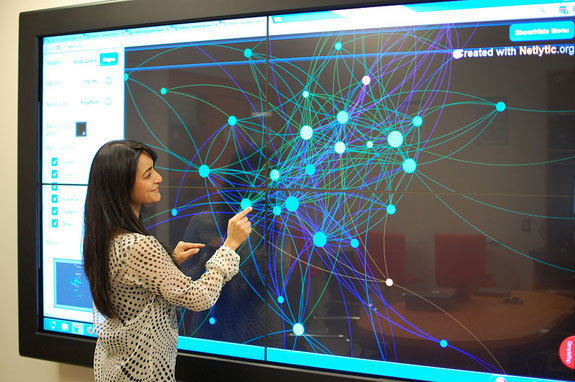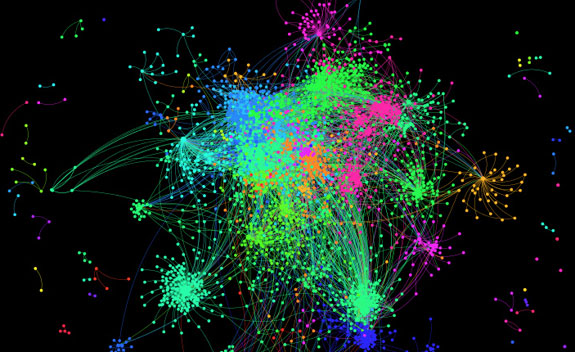

Computer Science PhD student Naureen Nizam demonstrates the "Magic Wall" at the Social Media Lab. The 96-inch multi-touch screen can display millions of online conversations. PHOTO: Social Media Lab.
(VANCOUVER) With an estimated 400 million tweets sent daily on Twitter, and over one billion active Facebook users, social media has become a leading contributor to an explosion of new data flowing from online sources.
For Dr. Anatoliy Gruzd at Dalhousie University, the capture and analysis of this “Big Data” can yield insights into important social, health, political and economic research questions. The challenge has been to develop ways of visualizing and managing such vast amounts of complex, unstructured data to best reveal underlying patterns and meanings for researchers – something not possible with conventional intelligence software.
An expert in social media and social networks analysis, Gruzd founded the multi-disciplinary Social Media Lab in 2010 to make headway in this area. Following two years of planning and construction, and the support of a $150,000 CFI Leaders Opportunity Fund grant and Dalhousie’s Faculty of Management to develop newly allocated space at the university, he launched a new facility in March 2013 dedicated to social media research – the first of its kind in Canada.
Equipped with high-speed servers, multi-touch screens, and other advanced tools, the new space offers researchers the computing power to collect and visualize countless gigabytes of social media conversations. The centerpiece: a 96-inch multi-touch display dubbed the “Magic Wall” able to display millions of social network connections on its single screen.
“The new equipment allows us to work with big data, and allows us to scale tools used to analyze social media to the societal level – we’re talking about billions of messages – and to be able to analyze and visualize them in real time,” said Gruzd.
The Lab serves researchers and students from information management, computer science, business, public administration, sociology, health, resource and environmental studies, and e-commerce, studying the social processes and relationships of online networks. New applications and methods have also been developed to identify patterns and connections buried in the plethora of data of interest to researchers. The aim is to better understand how social media impacts our lives and reduce the information overload.
“Advancements made [at the Social Media Lab] will help businesses, government and not-for-profit organizations to understand the context of our social interactions online and how these interactions help to shape and influence our society,” said Peggy Cunningham, Professor and Dean of the Faculty of Management at Dalhousie, in a press release about the opening.
Lab initiatives exploring the inner workings of online networks
For Gruzd, the increasing need by social scientists for tools that take advantage of Big Data has encouraged new developments in data analysis informed by sociological and social network research. It’s what distinguishes the Social Media Lab from other research centres: analysis of online conversations as social networks.
“It’s quite a crowded market for social media tools,” said Gruzd. “What we offer at the Social Media Lab is unique in the sense that we’re looking at online communications, not just from topical perspective (what they say), but more importantly who is talking to whom. Once you visualize conversations in a network format, it allows you to reduce the number of data points and to get a god’s eye view of the network as a whole, and to see how individuals in the network are connected and interact with one another.”
Sophisticated web-based tools developed at the Lab allow researchers to probe galaxies of online social interactions and identify inner social structures or clusters. The analysis can uncover leading topics, trends and other patterns, such as why some people become active members of the group, and some never post a message.

Twitter Communications Network as captured and visualized by Netlytic, one of the the analytic tools being developed at the Dalhousie Social Media Lab. CREDIT: Social Media Lab
Netlytic, a cloud-based analytic tool is designed to analyze public conversations from social media sites such as Twitter, YouTube, blogs, online forums and chats. Using this tool in empirical research, social scientists are learning about the behaviours and relationships of network members, and what influence online relationships have on personal choices and actions – something of particular significance to the business intelligence and analytics sector.
“In the private sector, there’s an increasing interest in knowing how clients are using their products and services, what they are saying about their companies. There’s a lot of interest in mining and discovering their thoughts and ideas about their products and services,” said Gruzd.
Another initiative is measuring political polarization during Canada’s 2011 federal election among users of microblogging platforms such as Twitter. The study may inform decision-makers at different levels of government on ways to best engage citizens through web technologies.
Gruzd is also leading the development of AcademiaMap – a web-based system designed to help scholars filter the “noise” from their Twitter streams and identify trending topics and interesting voices to follow. Working with the University of Toronto’s NETLAB led by Dr. Barry Wellman and University of Alberta’s Service Systems Research Group led by Dr. Eleni Stroulia, Lab researchers have adapted AcademiaMap and other visualization tools to assess and improve the management of GRAND’s own network. The goal is to learn how large, multifaceted and collaborative research networks can be optimized.
Student entrepreneurs attracting investors
GRAND has also been working with Gruzd to build relationships with businesses looking to commercialize the Lab’s social media apps. The professor strongly supports student-led entrepreneurship, and has helped students connect with businesses, media as well as various public funding agencies.
Through Gruzd’s guidance, master’s student Sreejata Chatterjee and her colleagues recently founded web-based social media lead generation company Leadsift, which recently secured a $500,000 capital investment under the the Launch36 accelerator program.
Social Media Lab has also partnered with international publisher Elsevier to integrate the research results into novel web apps for SciVerse, the company’s bibliographic database system. Elsevier recently contributed $3,000 in prizes for Dalhousie students to partake in a design concept competition. The ten best concepts were developed into applications to be used by over 15 million researchers, medical professionals, librarians and students.
Upcoming Dalhousie conference to focus on the study of social media
Businesses and other organizations regularly seek the expert advice of the Social Media Lab on best practices with social media technology. The lab organizes a number of well-attended lectures and public events to discuss ongoing research.
In September 2013, the Social Media Lab will hold its first International Conference on Social Media and Society at Dalhousie. The two-day event will cover wide ranging topics related to online communities, social media, visualization and Big Data.
In 2012, the Lab hosted the International Symposium on Measuring Influence on Social Media co-funded by GRAND, Mitacs and Dalhousie. Over 100 academics and business leaders from more than forty universities, companies, and other organizations in ten countries attended the symposium to share ideas on how to best study and measure the influence of social media.
Scholars at the 2012 symposium have been invited to contribute to a forthcoming special issue of the American Behavioral Scientist, a leading social and behavioral sciences journal, on the subject of ‘influence’ in online and offline social networks. Dr. Barry Wellman (GRAND PNI) and Gruzd are co-editing the edition.
-30-
Contact:
Spencer Rose
Communications Officer
GRAND NCE